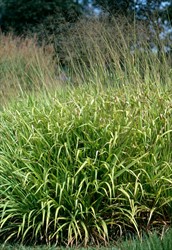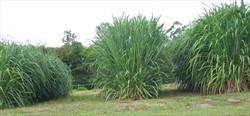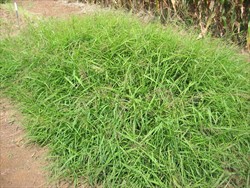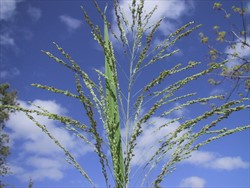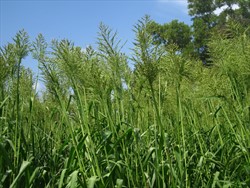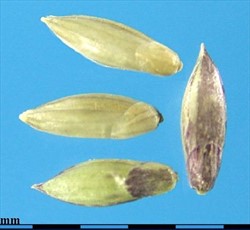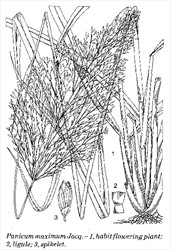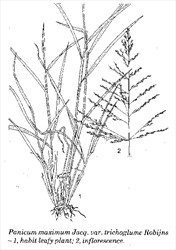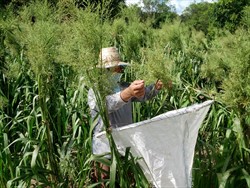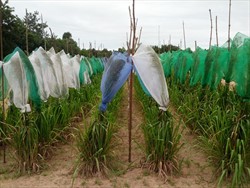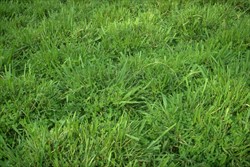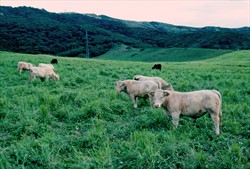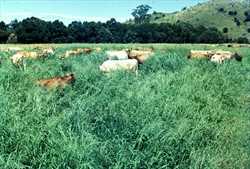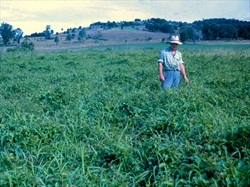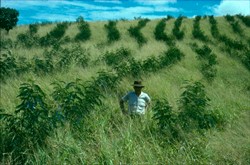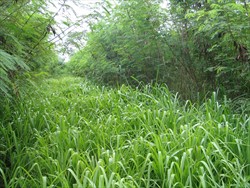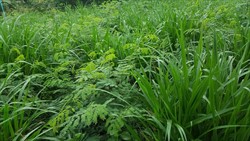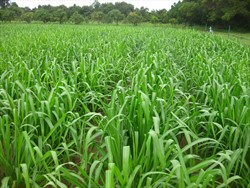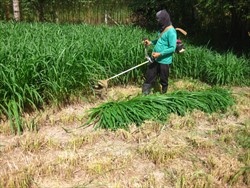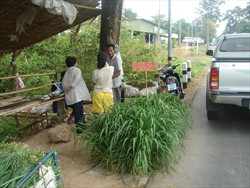Megathyrsus maximus
Tropical Forages
Megathyrsus maximus (Jacq.) B.K. Simon & S.W.L. Jacobs
Subordinate taxa:
Megathyrsus maximus (Jacq.) B.K. Simon & S.W.L. Jacobs var. maximus
Megathyrsus maximus (Jacq.) B.K. Simon & S.W.L. Jacobs var. coloratus (C.T. White) B.K. Simon & S.W.L. Jacobs
Megathyrsus maximus (Jacq.) B.K. Simon & S.W.L. Jacobs var. pubiglumis (K. Schum.) B.K. Simon & S.W.L. Jacobs
M. maximus: Basionym: Panicum maximum Jacq.; Panicum hirsutissimum Steud.; Panicum maximum var. hirsutissimum (Steud.) Oliv.; Panicum maximum var. trichoglume Robyns; Urochloa maxima (Jacq.) R.D. Webster
var. coloratus: Basionym: Panicum maximum var. coloratum C.T. White
var. pubiglumis: Basionym: Panicum maximum var. pubiglume K. Schum.
Family: Poaceae (alt. Gramineae) subfamily: Panicoideae tribe: Paniceae subtribe: Melinidinae.
Extremely variable species, loosely to densely tufted, shortly rhizomatous, erect or geniculately ascending, often branched, nodes usually bearded, sometimes rooting at the lower nodes. Leaf blades linear to narrowly lanceolate, keeled and sharp at the margins, often densely hairy at the base; ligule short (inconspicuous), membranous with tuft of dense hairs immediately above it.; leaf sheath hairy, sometimes bristly, slightly overlapping or compressed. Panicle open, oblong or pyramidal; primary panicle branches ascending, or spreading; whorled at lower nodes; secondary branches well developed and flexuous; spikelets usually openly inserted along the branches. Spikelets green or purple, oblong, blunt or acute, rounded on the back; upper lemma strongly transversely rugose.
Because of the morphological and agronomic variability, the species is treated here as 2 broad non-taxonomic types:
Tall/medium (TM) type: tussock, mostly >1.5 m in flower; robust perennials (sometimes annuals or short-lived perennials), 1.5‒3.5 m tall, with stems to about 10 mm diameter. Leaf blades glabrous to hairy, 40‒100 cm long, 1‒3.5 (rarely ‒5) cm wide, tapering to fine point. Panicle, 12‒45 (‒60) cm long, and 12‒25 (‒30) cm wide, spikelets 2.5‒3 (‒5) mm long; 700,000‒2 million seeds/ per kg. Commonly referred to as "guinea grass" or "giant guinea grass".
Short (S) type: tussock, mostly <1.5 m in flower; perennials, 0.5‒1.5 (‒1.8) m tall, stems to about 5 mm diameter. Leaf blades glabrous to hairy, to 1.4 cm wide. Panicle 18‒20 cm long and 15‒18 cm wide, spikelets 2.5‒3.5 mm long; 1.5 million seeds per kg. Commonly referred to as "panics".
Africa, Southern: gewone buffelsgras, groot panicum, soetgras, blousaadgras, blousaadsoetgras, brown-top buffelgras, brown-top buffelsgras, buffelgras, buffelsgras, purple-top buffelgras, purple-top buffelsgras, Mutale-witbuffelgras, blousaad soetgras, bush buffelgras, bush buffelsgras (Afrikaans); capim de guinémbulu ia-toto, oceka, ohota-hota (Angola); mfhafha, mphaga (Botswana); bobonare, lehola, mofantsoe (Lesotho); chibuze, chihunze, chiundze, chiundzi, dipunde, lipumbe, naporre (Mozambique); goho, g|aun|a'a (Ju|'hoan, Namibia); malianjashi (Rumanyo, Namibia); lissuane (Swaziland); mundundu (Zambia); uHatshi, umhatji (Ndebele, Zimbabwe); chamuzenene, nsenkenene (Tonga, Zimbabwe); chiTserere, chiVavane (Zezeru, Zimbabwe); garangichi (Zimbabwe); amayakayaka, olukulu, ubabe, ubabeolukulu (Zulu)
Africa, Central & Western: ekoro a bolo, makok, makoko (Cameroon); go, kogbe, nkye kyer, nkyekyer, nto (Ghana); mengui serhé (Guinea); siluntentamo (Guinea-Bissau); agarama, ikin, ikpo mili, iran akun, nnyanyangà eneng, oke achalà, oke acharà, pere osi, pere usi (Nigeria); bu silita, busilitaa (Senegal); ngalei hei (Sierra Leone)
Africa, Eastern: achuko, achuku, odunyo; arabsa, baldhoole, baldoli, weineh (Somalia); edinyo (Ateso, Uganda); otok (Acholi, Uganda); businyande (Gisu, Uganda); odunyo (Lango, Uganda); mukonzikonzi (Luganda, Uganda); nabititi (Lugisu, Uganda); orukonzi (Lunyoro, Uganda); odunyo, otok (Luo, Uganda); mukonde, musekende (Lusoga, Uganda); obuterante (Runyankole/Rukiga, Uganda)
Asia: hhash el gînâ (Arabic); 大黍 da shu, yang cao (China); rumput banggala (Indonesian), suket londo (Javanese), rebha luh-buluhan (Madura); rumput gajah (Indonesia); ginea kibi (Japan); nga faed (Laos); rebha luh-buluhan, rumput benggala, rumput kuda, rumput sarang sesak (Malaysia); ya-kinni (Thailand); güyana otu (Turkey); co kê to (Vietnam)
Caribbean: zèb giné, zèb ginén, z’herbe guinee
English: Guinea grass, buffalo grass, bush buffalo grass, purple-top buffalo grass, rainbow grass, Sabi panicum, Tanganyika grass, ubabe grass
Europe: capime guiné, fataque, herbe de guinée, panic élevé; herbe fataque (Créole) (French); grosses Hirsegras, Guineagras (German); erba della guinea, erba di guinea (Italian); guineagräs (Swedish)
Indian Ocean: umbara (Comores); ahibe, famoa, fantaka, tsimparifary, verotsanga (Madagascar)
Indian subcontinent: giiniigaas, gini ghaus, gini hullu (India); gini ghans (Nepal); ratatana, giniopilli (Sri Lanka)
Latin America: capim guine, capim-colonião, capim de Angola, capim de feixe, erva da Guine, morubú, capim-colonião, capim-sempre-verde, capim-da-colônia, capim-guaçu, capim-murumbu, capim-de-planta, capim-de-cavalo, capim-de-mula, capim-de-corte, capim-navalha (Brazil); pasto guinea, mijo de guinea (Argentina); guinea pajarito, hierba india, india, pajarito, saboya (Colombia); zabolla (Ecuador); zacate barqueño, zacate de barco (El Salvador); sagádi guinea, walang sikka (Nicaragua); camalote, hoja fina, panizo de guinea, pasto guineo, provilegio, rabo de mula, zacate guinea, zacate privilegio, zacatón (Mexico); pasto guinea, yerba Abadía, zaina (Peru); gramalote, matalote, melusa (Puerto Rico); hierba de india (Venezuela)
Pacific: paki ngeni (Chuuk); talapi, tine, tinikarati (Cook Islands); vao kini (Samoa); saafa (Tonga)
Short types:
English: Panic, green panic (Australia), slender guinea grass (Kenya)
Mozambique: tengou
Latin America: castilla (Peru)
Native:
Africa: Angola; Benin; Botswana; Cameroon; Côte d'Ivoire; Democratic Republic of the Congo; Eritrea; Ethiopia; Ghana; Kenya; Lesotho; Liberia; Malawi; Mozambique; Namibia; Nigeria; Senegal; Sierra Leone; Somalia; South Africa; Sudan; Swaziland; Tanzania; Uganda; Zambia; Zimbabwe
Indian Ocean: Madagascar; Mauritius
Cultivated/naturalized:
Asia: China (Guangdong); Japan; Taiwan
Australasia: Australia (New South Wales, Northern Territory, Queensland, South Australia (s.e.), Western Australia); New Zealand
Pacific: Galapagos Islands; Hawaii
Northern America: USA (Florida); Mexico
Caribbean: Bahamas; Cuba; Guadeloupe; Hispaniola; Jamaica; Puerto Rico
Central America: Costa Rica; El Salvador; Guatemala; Honduras; Nicaragua; Panama
South America: Argentina; Bolivia; Brazil (Amazonas, Goiás, Mato Grosso, Mato Grosso do Sul, Minas Gerais, São Paulo); Colombia; Ecuador; French Guiana; Guyana; Paraguay; Peru
Forage
Long term pasture if fertility maintained. Ideal for cut-and-carry, although bristly types may cause discomfort to forage collector. Reasonably palatable when mature, providing good roughage for use in conjunction with urea molasses supplements. Has been used successfully for making silage and hay.
Environment
Suited to agroforestry due to shade tolerance. Suggested for alcohol production as a biofuel.
Other
Used in folk medicine, for thatch, basket weaving and broom manufacture.
Soil requirements
M. maximus grows in most soil types providing they are well-drained, moist and fertile, although some varieties are tolerant of lower fertility and poorer drainage. Tolerance of low soil pH and high Al+++ saturation is also variable. 'Vencedor' and 'Centenário' were bred for these tolerances; other varieties require liming on acid ultisols and oxisols for best results. The species is generally intolerant of waterlogging or salinity.
Moisture
TM (tall/medium) varieties are mostly grown in areas with annual rainfall from (900‒) 1,100 to 2, 500 (‒4,000) mm, while S (short) varieties are usually planted in areas with (600‒) 800‒1,100 (‒1,500) mm. Drought tolerance varies among cultivars, although generally they do not tolerate dry periods longer than 4 or 5 months. Tolerant of short term flooding by moving water.
Temperature
Occurs from sea level to >2,000 m. Temperature response varies with genotype. S varieties are generally less affected by cooler temperatures than are many of the TM varieties, producing good early season growth. TM varieties generally produce most growth in the middle of the warm season, and although this varies somewhat with accession/cultivar, this type is not recommended for the subtropics or high altitude tropics.
Light
M. maximus grows naturally in open woodlands and grasslands, usually under or near trees and shrubs, and along riverbanks. It grows well in full sunlight but has been recorded as growing better at 30% shade, although yields are reduced by half at 50% shade. Some varieties are recognised for their ability to grow in shaded conditions, e.g. 'Petrie'.
Reproductive development
Flowering triggers apparently vary with provenance or cultivar, some producing a single flush of flowering ('Mombaça', 'Tanzania', 'Tobiatã') while others ('Centauro', 'Vencedor') may produce 2‒3 flushes. 'Makueni' and 'Riversdale' are indeterminate, while 'Hamil' and 'Colonião' are short day plants. 'Petrie' and 'Gatton' are largely insensitive to daylength, and flower from early summer to late autumn in the subtropics.
Defoliation
Susceptible to frequent low cutting. For long-term maintenance of stand, TM varieties should not be cut or grazed below about 30 cm, and should be cut or grazed at about 4-weekly intervals to obtain best balance between quality and quantity. S varieties can be grazed lower, but still are better under a rotational regime.
Fire
Fire does not cause long-term damage.
Guidelines for establishment and management of sown forages.
Establishment
Germination should be tested, since seed of some genotypes may not reach maximum germination until up to 18 months after harvest, while others may take only a few months. Dormancy can be overcome by removal of glumes from fresh seed. Seed can be drilled or broadcast at 2‒3 kg/ha, and being a small seed, should be planted at no more than 1 cm deep. Rolling after sowing improves germination and establishment. M. maximus can also be established from rooted tillers (or cuttings with thick stemmed varieties) planted on the contour every 0.5‒0.6 m in rows 1.25‒1.5 m apart, or as close as 40 cm in a triangular pattern if a faster cover is required.
Fertilizer
Establishment fertilizer is necessary on infertile soils, using 20‒40 kg/ha P, and about 50 kg/ha N if limited cultivation prior to planting. Maintenance fertilizer is needed for pure grass swards especially in cut-and-carry systems. Inadequate N leads to weakening of the stand and invasion by less desirable species. Maintenance dressings of 200‒400 kg/ha/yr N are required to promote healthy, productive stands on less fertile soils, particularly in moister environments. Soils with a pH <5 require addition of lime to raise pH to 5.5‒6.
Compatibility (with other species)
Combines well with twining legumes under light grazing. As these legumes are generally less tolerant of grazing than the grass, the legume component declines and weeds increase under heavier grazing. M. maximus should not be planted with less palatable grasses. This leads to preferential selection by livestock and decline of M. maximus. It can be grown successfully under open forest or plantation due to shade tolerance.
Companion species
Grasses: Chloris gayana, Megathyrsus maximus × infestus.
Legumes: Centrosema molle, Neustanthus phaseoloides, Macroptilium atropurpureum, Neonotonia wighti, Stylosanthes guianensis, S. capitata, S. macrocephala, Leucaena leucocephala.
S varieties, which are often grown on less acid soils in lower rainfall subtropical environments, may be grown with Clitoria ternatea, Desmanthus leptophyllus, D. virgatus[1] [2] [3], and Medicago sativa.
Pests and diseases
Ergot (Claviceps spp.), and other fungal diseases, Conidiospormyces ayresii, Fusarium roseum, and Tilletia sp., can reduce seed yields when conditions are favourable to the pathogen. Seed production has also been adversely affected by a smut (Ustilago sp.) in Colombia and bunt in the Rift Valley of Kenya. A leaf spot caused by Cercospora fusimaculosus has been recorded in Puerto Rico.
Spittlebug (English), cigarrinha (Brazil), chicharrita (Argentina), salivazo (Colombia) (Notozulia entreriana, Deois flavopicta, D. incompleta, Mahanarva spp., Aeneolamia reducta, A. selecta (Homoptera: Cercopidae) affects some cultivars in tropical America. 'Colonião', 'Tobiatã', 'Vencedor' and 'Gatton' are very susceptible to spittlebug attack.
Ability to spread
As guinea grass is reasonably palatable, spread is minimal or slow under grazed conditions. It is a very effective coloniser in ungrazed areas, particularly where some form of soil disturbance has occurred.
Weed potential
M. maximus spreads along water courses and ungrazed roadsides, and has been listed as a weed in many countries. It is a major weed in sugar-cane fields, due to its ability to grow under shaded conditions.
Nutritive value
IVDMD from 64% (2 week regrowth) to 50% (8 week regrowth). Crude protein from 6 to 25% depending on age and N supply. Seasonally, CP values in 12 weeks old regrowth commonly range from 5 to 10%, P levels from 0.15 to 0.18%, Ca from 0.6 to 0.8% and Na from 0.07 to 0.12%.
Palatability/acceptability
M. maximus is well eaten by all classes of grazing livestock, with particularly high intakes of young leafy growth. It is also used for feeding fish in Vietnam.
Toxicity
In South Africa, it is suspected of causing "dikoor" in sheep, a photosensitisation disease, perhaps linked to smut infection. The plant is also said to cause fatal colic if eaten too wet or in excess. 'Petrie' has been implicated in hyperparathyroidism ('big head') in horses, and occasionally nephrosis or hypocalcaemia in ruminants, due to oxalate accumulation.
Feedipedia link
Dry matter
Commonly (10‒) 20‒30 (‒60) t/ha DM, depending on variety and growing conditions (particularly if high levels of N applied).
Animal production
Can achieve up to 0.8 kg/hd/day LWG and up to 1,200 kg/ha/yr LWG (commonly 300‒500 kg/ha/yr LWG) depending primarily on stocking rate, N fertilizer rate and age of regrowth.
x = 8, 9, 16; 2n = 16, 18, 32, 36, 48. Primarily a facultative apomict in which both apospory and pseudogamy occur. The amount of sexual reproduction generally varies from 1 to 5 percent depending on the variety, although sexual lines have been identified. Sexual diploids have been identified in very few areas in Tanzania but are rare. Apomicts are always polyploid, especially tetraploid (2n = 32).
Best carried out in environments with longer day lengths and distinct dry seasons. Seed ripens unevenly, and is shed as it matures. Highest seed yield (19% recovery) obtained when the panicle has shed 40‒60 percent of its spikelets, which occurs about 12‒14 days from panicle emergence. Direct heading is less efficient in terms of seed recovery than mowing, windrowing and sweating. Yields of 50‒100 kg pure seed yield are common from machine harvest, and around 200 kg/ha from ground sweeping, and up to 750 kg/ha from hand-harvesting.
Atrazine can be used for weed control in M. maximus at 4 L/ha. 'Gatton' can tolerate over 4.5 kg/ha a.i. of atrazine, whereas common weeds such as Nicandra physaloides, Raphanus raphanistrum, Argemone ochroleuca, Ageratum conyzoides, Sida cordifolia and Eleusine indica are killed at 0.9 kg/ha a.i.
Broadleaf weeds can be controlled using a pre-emergent spray (no wetting agent required) of 2,4-D sodium salt at 4.5 kg/ha of an 840 g/kg a.i. product using a minimum of 340 L/ha of water. M. maximus is susceptible to glyphosate and readily controlled by drizzle applications. Young plants are susceptible to selective grass-killers, and to diuron at 2.5 kg/ha of an 800 g/kg a.i. Mature plants can also be killed using 2,2-DPA at 2.3 kg of a 740 g/kg a.i. product plus paraquat at 85 mL of a 200 g/L a.i. product plus wetting agent at 250 ml per 200 L of water, spraying to point of runoff.
- Very leafy.
- High quality feed.
- High production potential.
- Readily eaten by all stock.
- Suited to grazing and cutting.
- Drought tolerant.
- Early season growth in some lines.
- Requires fertile soils.
- Mostly intolerant of waterlogging.
- Intolerant of continuous heavy grazing.
- Some ecotypes become stemmy if not cut or grazed frequently.
Bogdan, A.V. (1977) Tropical Pasture and Fodder Plants. Longman Inc., New York, USA. p. 181–191.
Chen, C.P. and Hutton, E.M. (1992) Panicum maximum Jacq. In: Mannetje, L.’t and Jones, R.M. (eds) Plant Resources of South-East Asia No. 4. Forages. Pudoc Scientific Publishers, Wageningen, the Netherlands. p. 161–163. edepot.wur.nl/327785
Clayton, W.D. and Renvoize, S.A. (1982) Gramineae (Part 3). In: Polhill, R.M. (ed) Flora of tropical East Africa. Royal Botanic Gardens, Kew, UK.
Gibbs Russell, G.E., Watson, L., Koekemoer, M., Smook, L., Barker, N.P., Anderson, H.M. and Dallwitz, M.J. (1990) Grasses of Southern Africa: An identification manual. Memoirs of the Botanical Survey of South Africa No. 58. Botanical Research Institute, Pretoria, South Africa.
Grof, B. and Harding, W.A.T. (1970) Dry matter yields and animal production of guinea grass (Panicum maximum) on the humid tropical coast of North Queensland. Tropical Grasslands 4:85–95. bit.ly/2ylKtFH
Harris, C.A., Boschma, S.P. and Moore, G. (2009) Developing a more productive, persistent panic grass cultivar. Tropical Grasslands 43:269–270. bit.ly/2UJyR6S
Harty, R.L., Hopkinson, J.M., English, B.H. and Alder, J. (1983) Germination, dormancy and longevity in stored seeds of Panicum maximum. Seed Science & Technology 11:341–351.
Hutton, E.M. (1989) Breeding acid soil tolerant lines of the tropical grass Panicum maximum Jacq. Proceedings of the XVI International Grassland Congress, Nice, France, 4–11 October 1989. p. 355–356.
Mannetje, L.'t and Kersten, S.M.M. (1992) Panicum maximum Jacq. var. trichoglume Robyns. In: Mannetje, L.’t and Jones, R.M. (eds) Plant Resources of South-East Asia No. 4. Forages. Pudoc Scientific Publishers, Wageningen, the Netherlands. p. 161–163. edepot.wur.nl/327785
McCosker, T.H. and Teitzel, J.K. (1976) A review of guinea grass (Panicum maximum) for the wet tropics of Australia. Tropical Grasslands 9:177–190. bit.ly/2WX5TDg
Middleton, C.H. and McCosker, T.H. (1975) Makueni, a new guinea grass for North Queensland. Queensland Agricultural Journal 101:351–355.
Savidan, Y.H., Jank, L. and Costa, J.C.G. (1990) Registro de 25 acessos selecionados de Panicum maximum. Embrapa Gado de Corte, Campo Grande, Brazil. bit.ly/3bDPMi1
TM types
'Aries' Released in Brazil (Matsuda, 2003). Hybrid between LSC2 ('Centauro') as the seed parent and 'Aruana' (creeping type). 1.2‒1.5 m tall. More tolerant of poor drainage and very low grazing (horses and sheep). Rapid regrowth after cutting/grazing. Can produce >1 t/ha/yr seed in 3 harvests.
'Atlas' Released in Brazil (Matsuda, 2003). Hybrid. Sexual types from 'Tobiatã' crossed with K68 from Côte d'Ivoire. 1.5‒2 m tall. Tolerant of high Al saturation, giving deeper root system and greater drought tolerance. Seed yields up to 600 kg/ha from a single harvest.
'BRS Quênia' Released in Brazil (2017). Hybrid with T72 as the pollen parent, developed by Embrapa Gado de Corte and partners. Intermediate-sized cultivar with medium to wide leaves and less stem than other medium to high commercial cultivars. For use in the states of Acre, Rondônia, Mato Grosso do Sul, Rio de Janeiro, Rio Grande do Sul and the Federal District. DM yield similar to 'Mombaça', but quality is higher. Selected for leafiness, high tillering, high productivity and ease of management. Stems are very soft and easily eaten by the animal, so management height is much lower and easier than 'Mombaça'. In evaluation under grazing, gave greater LWG than 'Tanzânia' and 'Mombaça'.
'BRS Zuri' (T65, BRA 7269) Released in Brazil (2014). Wild collection from between Korogwe and Kilosa, Tanzania. Tall, wide-leafed type selected for use in the Amazon and Cerrado regions by virtue of high production, high nutritional value, resistance to spittlebug/cigarrinha and high resistance to leaf spot caused by the fungus Bipolaris maydis that infects 'Tanzânia' in those areas. It has similar moderate tolerance of soil waterlogging to 'Tânzania'', but develops better in well-drained soils. Low drought tolerance. Best managed on rotational basis to maintain stand structure and minimize flowering and stemminess.
'Centenário' Released in Brazil (1986). Hybrid. Perennial to 2 m tall. Drought tolerant. Tolerant of high Al saturation. Resistant to spittlebug.
'Centauro' Released in Brazil (1988) by IAC (Instituto Agronômico de Campinas, SP, Brazil). Apomictic hybrid between Zimbabwean 'Katerere' and the sexual line 40 (derived from PI 277944). 1.2 m tall, narrow, medium length, dark green leaves and a bluish stem, which, like the leaves, sheaths and ligules, is glabrous; good frost tolerance, moderate fertility soils.
'Colonião' (BRA 004723, BRA 003824, BRA 003841) Released in Brazil. The oldest accession of M. maximus in Brazil, brought with the slaves in the sixteenth century. Perennial 2.0‒2.5 (‒3.0) m tall; glaucous stems to >1 cm diameter. Leaves grey-green, 80‒90 cm long, 2.5‒3 cm wide; leaf sheath glabrous, except for few short hairs near collar. Panicle 20‒50 cm long, 15‒30 cm wide. Drought tolerant. Susceptible to spittlebug.
'Hamil' (BRA 004731, ORSTOM G76) Released in Australia (1956). A giant form, 2.0-3.0 (‒4) m tall, rooting freely from stem nodes in contact with moist soil; more robust and coarser in appearance than common types, comparable to 'Colonião' type but with dense, stiff hairs on the basal leaf-sheath. Leaf blades are softly hairy, and upright. Drought tolerant. Well accepted by cattle, even when mature. Late flowering, commencing flowering early to mid-April at 26º S. Seed set is poor but is rather higher than in most other varieties. Seeds about 2.3‒2.5 mm long, ellipsoidal, straw-coloured, ±1,600,000 per kg.
'IPR 86 Milênio' (ORSTOM K249, BRA 006998) Released in Paraná, Brazil (1999). Origin Nairobi, Kenya. Large tussocks to 1.65 m tall, leaves long, to 3.5 cm wide, with dense coarse short hairs on leaf blades and sheath. For well-fertilized, intensive production systems.
'IZ 1' (Acc. No. 80) Released in Brazil. A selection and purification to achieve the botanic "typus" of 'Colonião'; leaves broad, dark green to blue, with a white wax on the upper surface.
'Likoni' (K 5829, ORSTOM G26, BRA 004375) Released in Kenya/Uganda (1952). Similar to 'Hamil' in plant height and leaf width, but with glabrous leaf sheath. Recommended for the high-rainfall areas (1,000‒1,270 mm) on the Kenya coastal strip. Also used in Cuba.
'Makueni' Released in Kenya (early 1960s), Australia (1973). From Makueni, Kenya (1º47' S, 37º37' E, 1,200 m asl, rainfall 910 mm). More robust than common types, but less robust and finer stemmed than giant cultivars, 'Hamil' and 'Colonião'; grows to 1.8‒2.4 m in height and with occasional short stolons. Leaves to 80‒100 cm long, 18‒22 mm wide, less erect than in 'Hamil', 'Colonião' and common. Distinguished from these varieties by virtue of dense hairiness of leaf blade, sheath, exposed stem and spikelet. Inflorescence about the same size as that of 'Colonião', larger than common guinea and smaller than in 'Hamil'; outer glumes of the spikelet covered in short dense hairs, while those of other varieties are glabrous; spikelets 3.0‒3.5 mm long. Annual dry matter yields are similar to those of other cultivars but higher (up to 25% of its total yield) in the cool season, compared with 20% for common and 15% for 'Colonião' and 'Hamil'.
'Megamax059' (PI 364366) Released in Australia (2017). Origin Mazeminham Experiment Station, Mozambique. Evaluated in the Mediterranean region of WA and the subhumid subtropical tablelands of northern NSW in Australia and SE Queensland. Medium height, moderately broad-leafed panic grass with good tillering and a high leaf to stem ratio. It is well-adapted to most soils providing they are well-drained and fertile. Selected for increased production, high persistence and cool season tolerance compared with other commercial sub-tropical grasses. It responds rapidly to rainfall even after prolonged dry periods. Tolerant of extended dry periods, but also of short-term flooding by moving water. Alternative to 'Gatton'.
'Miyagi' Registered by Matsuda in Brazil. Thought to be the same as 'Mun River' (see below).
'Mombaça'/ Mombasa' (IRD/ORSTOM K190A, BRA 006645, CIAT 6962) Released in Brazil (1993). Origin near Korogwe, Tanzania (5.20° S 38.50° E, 290 m asl, rainfall 1,050 mm). Large tussocks to 1.65 m, stems tinged with purple. Leaves long, to 3 cm wide, with short hairs on the upper surface; leaf sheaths glabrous. Hand harvested clean seed yield ca 140 kg/ha (av.7 years) and up to 470 kg/ha. High resistance to spittlebug. Good drought and cold tolerance. Dry matter yield 28% more than that of 'Tanzânia-1'. Liveweight gains of 770 kg/ha/yr compared with 600 and 590 kg/ha/yr from 'Tanzânia-1' and 'Tobiatã'. Although selected in the humid tropics, it is proving popular in the Middle East and Spain.
'Mun River' Released in Thailand (2017). Aberrant type discovered in a field of 'Mombaça' in the State of Mato Grosso, Brazil. Differs from 'Mombaça' in having softer, near-glabrous leaves in new growth, and markedly less serrulate leaf blade margins than 'Mombasa'. The most obvious differences compared with 'Mombaça' are the absence of any purple colouration in the stems and in the close packing of the spikelets in 'Mun River', giving an overall denser appearance to the seedhead. Clean seed yields of up to 750 kg/ha have been obtained with hand-harvesting. Dry matter yields similar to those of 'Mombaça' in the dry season and somewhat greater in the wet season, and greater than those of 'Tanzânia-1' in both seasons.
'Mutale' Released in South Africa. Origin northern Limpopo Province, South Africa. Very leafy and remains in the vegetative stage till late in the growing season. Because seed is only formed late in the season, 'Mutale' is very good as standing hay.
'Natsukaze' Released in Japan (1985). Hybrid (tetraploid 2n = 32) from Kyushu National Agricultural Experiment Station, Kumamoto, Japan. Erect, leafy, annual/short-lived perennial to about 2 m tall; 85% apomictic. Selected for early growth vigour and high dry matter yield. High resistance to root knot nematodes (Meloidogyne spp.).
'Natsuyataka' Released in Japan (1988). Hybrid (tetraploid 2n = 32; apomict) from Kyushu National Agricultural Experiment Station, Kumamoto, Japan. Semi-erect, tufted perennial to ca 2 m, rooting freely from stem nodes when in contact with or in close proximity to moist soil. Leaf sheaths largely glabrous. Similar in appearance to 'Gatton'. Selected for persistence and high dry matter yields. Good regrowth after cutting. Adapted to well-drained fertile or moderately fertile soils in humid subtropical and tropical environments. Best on acid soils (pH 4.8‒6.7). Early growth is slower than in 'Natsukaze' but equal to that of 'Gatton' and 'Petrie'.
'Ntchisi' Released in Kenya, Malawi, Zambia (1959). Originating from the Dowa-Ntchisi Highlands, Malawi (13°17' S, 1,300 m asl, rainfall 900 mm) Giant type, stems hairless, bluish-green leaves, panicle distinctive dark brown colour. Often propagated vegetatively. Suitable for cut-and-carry, silage and grazing.
'Reyan Nos. 8 & 9' Released in China (2000). Selected for adaptation to poor acid soils, drought, waterlogging and shade in Hainan and Yunnan Provinces.
'Riversdale' Released in Australia (1975). Tall, erect, tufted perennial with a few short creeping rhizomes. Selected from 'Common' to remove 'coarse guinea' contaminant. Leaves held more erect than those of 'Makueni'. Leaves about the same length as those of 'Hamil' (70‒80 cm in mature plants) but shorter than those of 'Makueni' and 'Colonião'; 15‒18 mm wide compared with those of 'Makueni' (18‒22 mm), 'Hamil' (24‒26 mm) and 'Colonião' (25-‒0 mm); blades softly hairy on the adaxial surface and sheath moderately hairy. Best in frost-free areas receiving >1,300 mm annual rainfall . Less tolerant of poor drainage than 'Hamil' and with dry matter yields comparable to those of other cultivars, although yielding less in winter, and more in summer than 'Makueni'.
'Sempre Verde' Released in Brazil. Not widespread, found mostly in N Minas Gerais and Bahia. Stems and leaves finer than those of 'Colonião'. Very drought resistant (hence its name) due to reserves accumulated in bulbous base of the culms. It requires medium soil fertility. Greater tolerance to high exchangeable aluminum than 'Colonião'.
'Si Muang', 'TD 58' (ORSTOM T58) Released in Thailand. See 'Tanzânia-1'. Commonly called "purple guinea". Readily established from rooted cuttings or seed.
'Tanzânia-1' (ORSTOM T[SH1]58, BRA 007218, CIAT 16031, CPATU 132) Released in Brazil (1990). From near Korogwe, Tanzania (5.15º S, 38.48º E, 300 m asl, rainfall 1,050 mm). Perennial , 1‒1.5 (‒>2) m tall, very leafy, purplish seedheads, moderate to high spittlebug resistance. Suitable for cut-and-carry or light grazing. Broader adaptation than many M. maximus TM types. Best adapted to areas with short or no dry season (but can survive long dry season). Moderate drought and cold tolerance. Leaf production 80% higher, seed production 30‒40% higher, and live weight gain/ha/year, 37%, higher than common guinea. Liveweight gain 720 g/hd/day during the wet and 240 g in the dry season; annual gains of 250 kg yearlings on 'Tanzânia-1', 'Tobiatã' and 'Colonião' of 520, 450 and 420 g/hd/day have been recorded.
'Tobiatã' (ORSTOM K187B, BRA 001511, CIAT 6299, ILCA 7160, CNPGC 132/78, CPATU 130, K 187, CPI 89251, CIAT 6960) Released in Brazil (1982). From near Mombo, Tanzania. A broad-leafed (to ca 5 cm), erect perennial to >2 m tall. Leaves pendulous. Stiff hairs on the leaf sheath may cause skin irritation in cut-and-carry system. Good drought tolerance, moderate cold tolerance. Reports of spittlebug resistance vary from high to very low. Early flowering (commencing early February at 26º S).
'Umtali' (G 438) Released in Zimbabwe. Origin near Mutare (formerly Umtali), Zimbabwe (19º S, 1,120 m asl, rainfall 790 mm). More persistent under summer grazing and flowers later than 'Sabi'. Could be suitable in tobacco rotations because not a host of Meloidogyne.
'Vencedor' (CIAT 26900, BRA 008826) Released in Brazil (1990). Hybrid resulting from crosses made in Colombia between the best 8 Megathyrsus maximus introductions and sexual 'Tift 49'. Initial selections were made from plants grown on an oxisol with pH 4.7 and Al and Ca saturation of 85.5% and 8.6% respectively. Tussock to 1.6 m tall, and leaves to 1.9 cm wide, with no waxiness or pilosity. Adapted to medium to high fertility soils, growing well in soils of pH <5. Produces around >20 t/ha dry matter (CP 8‒14% IVDMD 64%), and 150‒200 kg/ha seed. Has good cold tolerance (temperatures down to 8 °C). Very shade tolerant, being one of the highest yielding tropical grasses at 55‒80% light transmission.
S type
'Gatton' (CPI 6563, ORSTOM G62, BRA 004642) Released in Australia (1964). Institutional collection from Zimbabwe, introduced as "brown buffel grass". Culms to about 1.5 m, almost glabrous, more robust than 'Petrie' with broader and longer leaves. Inflorescence 18‒20 cm long, 15‒18 cm wide at the lowest primary branch, lower branches are usually whorled; spikelets 2.6‒2.9 mm long; 1.4 million seeds/kg. Adapted to subtropical and tropical areas receiving between 760 and 1,000 mm of rain annually (similar to 'Petrie'). Has a longer growing season and appears also to utilise soil nitrogen better than 'Petrie'. Seed yields about 100 kg/ha.
'G2' Accepted under PBR in Australia (2009). Tetraploid perennial, discovered as an aberrant leafy plant with long, soft leaves in an isolated plot of ‘Natsukaze’. Appears to have resulted from sexual reproduction in the (normally) apomictic ‘Natsukaze’, it has remained true-to-type throughout >4 cycles of seed multiplication at Sheldon and Walkamin during 2003‒02008. The original plant has maintained a strong vigorous perennial growth habit for >8 years, unlike the parent ‘Natsukaze’ which is a short-lived perennial that loses vigour in the second year after planting.
'Megamax049' Released in Australia (2017). Origin Zimbabwe (21° S, 560 m asl, rainfall 450 mm). Evaluated in the Mediterranean region of WA and the subhumid subtropical tablelands of northern NSW in Australia and SE Queensland. Early flowering, fine-stemmed, perennial, short to medium panic with dense, soft, fine foliage and medium to high tiller density. Selected for increased production, high persistence and cool season tolerance in comparison to other commercial sub-tropical grasses. Alternative to 'Petrie'.
'Natsukomaki' Released in Japan. Hybrid from Kyushu National Agricultural Experiment Station, Kumamoto, Japan. Low growing, fine stemmed, small leafed variety selected for treading resistance, drying rate and flexibility of culms for hay.
'Petrie' Released in Australia (1966). Origin unknown. Formerly P. maximum var. trichoglume, often referred to as "green panic". Tufted, summer-growing perennial, mostly to 1 (occasionally to 1.8) m tall. Usually paler green and more conspicuously hairy than 'Gatton' and 'Sabi'. Spikelets 2.5‒3.5 mm long, glumes covered with fine hairs; 1.5 million seeds (2.4 million caryopses) per kg. Adapted to areas with rainfall from 650 to 1,750 mm/yr (not as well suited to high rainfall as many taller varieties). More susceptible to frost than Chloris gayana. Has moderate to good drought tolerance, and responds quickly to rain. Best growth is made during early spring, better than Cenchrus ciliaris or Chloris gayana. Very shade tolerant. It will grow satisfactorily on soils with pH 5‒8, but best on those with an acid or neutral reaction. Flowers from early summer to late autumn. Seed does not ripen evenly and shatters badly; has a long period of dormancy, not reaching maximum viability until about 18 months after harvest. Does not tolerate heavy grazing.
'PUK P8' Released in South Africa. Origin Bethlehem, Free State, South Africa (28.2º S, 1,700 m asl, rainfall 800 mm, temperature falls to -13 ºC for 10‒14 days/year). Selected by the Potchefstroom University. Morphologically similar to, but more productive than 'Gatton'. Observed to withstand winter without any cold injury under natural conditions. Marketed by Agricol Seed.
'Sabi' (CPI 28275, K5881) Released in Zimbabwe. Origin Sabi River Valley, Zimbabwe. Less erect than 'Petrie', to 1.5 m, and with narrower, glabrous bluish green leaves and smaller spikelets. More tolerant of waterlogging than other varieties, and can grow on a variety of soils. Moderately drought tolerant. Good seed producer. Used in rotations with tobacco due to resistance to rootknot nematode.
CIAT 668, 673, 690, 696. Selected in Colombia. High dry season yields in highly acid, Al-rich soil, low in available P.
CIAT 6799, 6944, 16019, 16042 Selected in Colombia (Carimagua). Well adapted to acid soils (pH 4.8) with high Al+++ saturation (90%).
CIAT 6171, 6172, 6177, 6506, 6629, 6798, 6799, 16021, 16024, 16065 Selected in Colombia (Carimagua). High resistance to spittlebug (Aeneolamia reducta).
CIAT 36000 Selected in Colombia. Best selection for low fertility, acid savannah soils for intensive beef and dairy.
CPAC 3017, 3024, 3003, 3013, 3012, 3059, 3016, 3067, 3025, 3050 Selected in Brazil (Ariquemes). Best adapted to environment of 36 M. maximus accessions tested.
CIAT 673 Selected in Vietnam. Broad-leafed variety used in cut-and-carry dairy systems around Ho Chi Minh City.
